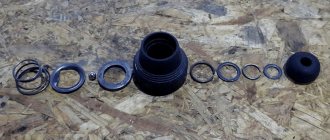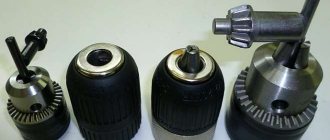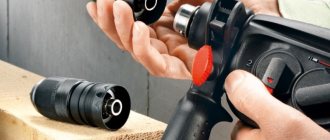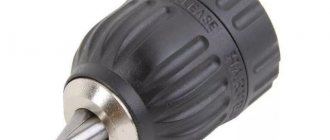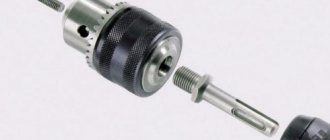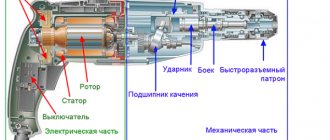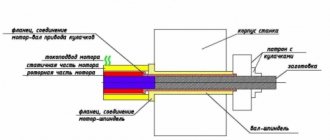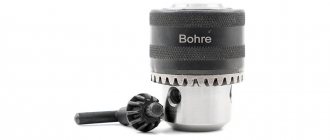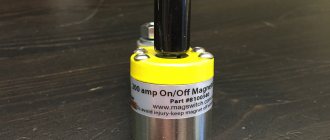The hammer drill, due to its drilling function and impact mechanism, makes it possible to perform a large number of operations. This is the usual drilling, slotting, chiselling, and so on. There are significantly more functions than a drill.
Rotary hammers are equipped with chucks on which various attachments are installed, depending on the task at hand.
The cartridge has a special design and fixation system. Due to this, you can quickly change attachments, but at the same time ensure their most reliable fixation.
The question often arises about the possible use of a conventional drill bit, which is used in a drill, on a rotary hammer. For these purposes, special adapters are used. What are they, how to choose them and work with them today, we’ll find out.
The device of the chuck for a hammer drill
Since its creation, the hammer drill has undergone many modifications, thanks to which it has gained particular popularity among both professional craftsmen and the common man.
At the moment, all tools of this type are equipped with an SDS system chuck, the design of which includes the following components:
- The central axis has the form of a sleeve with splines.
- A ring is put on the sleeve.
- The ring, in turn, is acted upon by a spring.
- Between the ring and the bushing you can see several moving balls.
Also, any cartridge has an outer protective cover. The selected nozzle is inserted with the rear end. In this case, the master needs to apply moderate pressure on the cover itself, after which the locking balls and spring move.
The ball clears the opening for the tail part of the nozzle. A characteristic click is an indicator of successful fixation.
Features of nozzles
Nozzles are used to carry out work on stone, concrete, brick and other surfaces. To ensure high efficiency, inserts based on metals with a high level of hardness are used.
Structurally, the cartridge nozzle includes several elements:
- fastening part;
- dust removal cavity;
- shank;
- spiral;
- core.
The faster the motor can rotate, the more efficiently the nozzle can move through materials.
Rotary hammer attachments are subject to increased quality requirements. This is due to the high power of the tool compared to a conventional drill. Therefore, the metal of the nozzles must withstand work in more difficult conditions and under heavy loads.
Main types of cartridges
The hammer drill is designed for a huge variety of jobs: drilling concrete walls and partitions, wooden structures, metal sheets. Accordingly, for each type of work performed, a certain type of nozzle and type of chuck are required.
Depending on this criterion, the following types of cartridges are distinguished:
- SDS plus is one of the most popular versions of chucks for rotary hammers. Such designs are excellent for use in household tools. The shanks for such a cartridge are 4 cm long and 0.1 cm in diameter.
- For professional tools with power above 1.1 kW, chucks from the SDS max series are used. Nozzles for such structures have a length of 9 cm and a rod diameter of 1.8 cm. The working area reaches 6 cm. Special crowns are used to drill holes more than 6 cm in diameter. Among the significant design features, it should be noted the presence of three splines, which allows the master to work with a hammer drill with an impact force of 30 joules.
- Sometimes, but quite rarely, you can find top series cartridges, for which drills are 1.4 cm thick and 7 cm long.
- In some stores and workshops you can see chucks for cylindrical shanks. Instead of grooves, such structures have slots and protrusions.
- The hex series of chucks were originally designed to hold chisels and picks, but their versatile design allows them to be used with drill bits as well.
For a series of chucks such as spline, special attachments are required. There is a seal on the shank of such nozzles that ensures movement of the working part.
How do chucks for hammer drills work?
To effectively use different hammer drill bits, you need to ensure that they are securely attached. A special cartridge is used for this. Its first models began to be developed back in the 30s of the last century, when hammer drills appeared on the market, the mass production of which was mastered by the world famous company Bosch.
Such a manual device as a hammer drill was almost immediately appreciated by consumers, since it can be used to combine drilling with pulse chiselling, which significantly increases the efficiency of the processing performed. The main drawback of the first models of rotary hammers was precisely due to the fact that the weakest link in their design was the cartridge, which quickly became unusable under the influence of shock loads.
As a result of long-term development, manufacturers of hammer drills and chucks have come to the following conclusion: the simpler the design of the clamping device, the more reliable it is in operation.
Externally, the hammer chuck is a completely closed clamping device
As a result, three main types of cartridges for rotary hammers were created, which in turn are divided into subtypes.
Gear-crown (key)
There are chucks in which the working attachment is fixed using a special key that activates cams that reliably clamp the shank of the tool being used. The most significant advantage of this type of chucks is that they provide reliable fastening of the tool used in conjunction with the hammer drill. Meanwhile, to replace the working tool in such a chuck for a hammer drill, you will need to spend significantly more time than when using other types of clamping devices.
The main types of chucks for rotary hammers
are Quick-release chucks (KLC).
The working attachment of a rotary hammer can be fixed on it using a quick-release chuck (KLC), which is activated only by the force created by the operator’s hands. Depending on the design, cartridges of this type can be single- or double-clutch, the operating principles of which also differ.
Single-socket chucks are easier to use, but they can only be used in conjunction with drills that have the ability to automatically lock the working shaft. To activate such a cartridge, the effort of one hand is sufficient. To use a double clutch clamp, you need to hold the rear clutch with one hand and rotate the front clutch with the other.
Collet type chucks
Not all rotary hammers belong to the modern SDS system. Today you can find tools with collet-type clamps, among which it should be noted:
- Key type cartridges. Such a fixing part allows the installation of a shank with a cylindrical rear part. Special slotted keys drive the cams, which ensures reliable fixation of the nozzle. Among the disadvantages, it should be noted the complexity and time consumption of installing and removing the working part.
- Among the collet-type models, quick-release chucks are also known. The principle of operation and design of such a part are similar to the clamps on screwdrivers.
Both types of cartridges should not be used in impact hammer drills, since the parts will quickly fail.
What are cartridges for?
Rotary hammers perform several different functions, allowing you to carry out different types of work. This is not only drilling, which is provided by a drill, but also dismantling, making grooves and much more. An appropriate drill, crown or drill is selected.
Structurally, rotary hammers may differ from each other, although they perform the same job. The point is to transmit torque from the motor to the nozzle. This is done through a gear system.
A cartridge is installed at the end of the hammer drill. This is a device that allows you to fix the drill. Since the hammer drill not only rotates the attachment, but also has an impact mechanism, it is impossible to use a cartridge from a conventional drill on it.
SDS cartridges are used here. Their advantage is the ability to withstand not only rotational loads, but also active reciprocating movements. If the cartridge fails, it is recommended to replace it.
Removing and replacing the cartridge
A very difficult situation arises when a hammer drill ceases to perform its functions during repair or construction work. One possible cause of the malfunction is a broken cartridge. In this case, the technician needs to remove and replace the part. Among the reasons for cartridge malfunction are:
- Complete wear of the locking balls or rollers. In this case, the cartridge does not secure the nozzle properly. Sometimes there are combined reasons, when the spring mechanism sags or the ring wears out.
- A completely different situation occurs when the cartridge is not held on the working part of the hammer drill. In this case, wear may occur on the brackets that are used to secure the chuck to the tool body.
In the latter scenario, a detailed selection of a new cartridge will be required, taking into account all its technical characteristics, design features, type of fastening and type of clamping device, groove, roller.
Instructions on how to remove the cartridge at home:
- The instrument body is carefully inspected for external mechanical damage.
- Using a screwdriver, slightly pry up the protective cover of the chuck (on various models of rotary hammers, this part can be located on the top or side surface of the body).
- The next step is to remove the retaining ring and remove the plate that lies below the ring.
- Next, remove the outer cover.
At this stage, all components of the chuck are visible, and the technician has the opportunity to find the cause of the tool malfunction.
Signs of wear may include cracks, chips, or pronounced irregularities on the surface of the retaining ring. If grease interferes with visual inspection, you should first remove it with a rag.
What is SDS
SDS (SDS) is an acronym made up of the first letters of the words Steck, Dreh, Sitzt, which translated from German mean “insert, turn, secured.” It is on this simple, but at the same time ingenious principle that the SDS cartridge, developed by Bosch engineers in the 80s of the last century, works. Today, 90% of all manufactured rotary hammers are equipped with these easy-to-use devices, which ensure high reliability of fixing the working tool.
SDS chucks are often called quick-release chucks, but they should not be confused with devices in which clamping is achieved by rotating the couplings. Unlike traditional quick-release chucks, the SDS clamp does not need to be rotated to secure the tool; you just need to hold it with your hand.
To understand the design of a hammer drill chuck of this type, as well as the principle of its operation, just look at the tool shank, which is designed to be fixed in such a device, or the SDS adapter. This shank has 4 grooves, two of which are open at the end of the shank, and the other two are closed. Open grooves act as guides; they ensure the correct position of the tool when it enters the chuck. The closed grooves, in turn, ensure the fixation of the shank in the hammer drill chuck.
Scheme of the impact mechanism of a rotary hammer
In the inner part of the SDS cartridge there are special balls that perform two functions simultaneously. At the moment when the tool is just inserted into the hammer drill, the balls along which the guide grooves move ensure its correct position. After the tool is inserted all the way, such balls fix it, for which it is necessary to turn it a little until the balls enter the closed grooves of the shank. To make using the SDS chuck even easier, it is recommended that the tool shank not only be thoroughly cleaned after each use, but also lubricated.
It should be borne in mind that due to the design features of SDS chucks, the tool that is fixed in them is subject to slight radial runout at idle, which does not in any way affect the accuracy of the processing performed. Meanwhile, the presence of a small play between the shank and the inner surface of the chuck protects the latter from the impact to which drills are exposed during the operation of the hammer drill.
To protect against contamination, all hammer drill chucks are equipped with rubber boots.
Chuck reassembly process
After repairs and replacement of the relevant parts of the cartridge, new lubricant will be applied. The reassembly process is carried out in the following sequence:
- A spring is placed on the central axis.
- The next step is to lay the plate (if a defect is found, the plate should be replaced).
- The locking ball is pre-coated with lubricant, and only then is it installed in the sleeve hole.
- The thrust ring is reinstalled.
After installing the protective cover, it is additionally secured with a locking ring. The last step is to install the boot.
